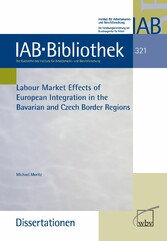Suchen und Finden
Service
Labour Market Effects of European Intergration in the Bavarian and Czech Border Regions
Michael Moritz, Institut für Arbeitsmarkt- und Berufsforschung (IAB)
Verlag wbv Media, 2009
ISBN 9783763940127 , 165 Seiten
Format PDF, OL
Kopierschutz Wasserzeichen
1 Introduction: Analysis of Labour Markets in Border Regions (p. 9)
1.1 Motivation
In the course of globalisation European countries are facing new challenges, which is particularly evident on the labour market. While employees in Western European countries are exposed to growing pressure from low-wage transition and developing countries primarily situated in Eastern Europe and Asia, the workers in these upcoming economies are also having to cope with the rapid changes. An idiosyncratic situation is arising in this regard at the direct frontier of “old” EU member states with the 2004 accession countries. From the Baltic to the Adriatic Sea a considerable number of EU citizens are affected by the economic integration process. In principle, border regions play a special role in an integration process, since effects of transnational competition should be stronger in the absence of the deterrence of costs incurred in order to overcome distance. Only in these regions do “some border crossing activities like commuting, shopping abroad or the cross-border rendering of services (e.g. in construction and crafts) make sense economically due to the short distance to the border” (Mayerhofer 2004: 74).
However, though impediments are decreasing, mental and language barriers still exist, leading to a special economic situation in border regions (Houtum 1999), as national borders still matter even in highly integrated areas (McCallum 1995; Bröcker 1998; Nitsch 2000; Gil-Pareja et al. 2006). According to McCallum (1995), all things being equal, trade between two regions within one country is about 20 times greater than cross-border trade. After the accession of the ten mostly Eastern European states, 25 % of the population in the EU25 countries are living in border regions, rising from 15 % in the EU15 countries. In the accession countries, as much as 58 % of the total population live in border regions1 (Resmini 2003). In the economic sense a border constitutes an institution which imposes (sometimes prohibitive) transaction costs on the exchange of goods and services between regions or countries (Büttner/Rincke 2007).
The opening of a border, in this case the fall of the Iron Curtain, leads to a sizable decline in the transaction costs which only then allows the mobility of goods, capital and labour. In the long run border regions are expected to benefit from growing trade opportunities, but with respect to labour markets, problems of adjustment are highly visible in the short term.



